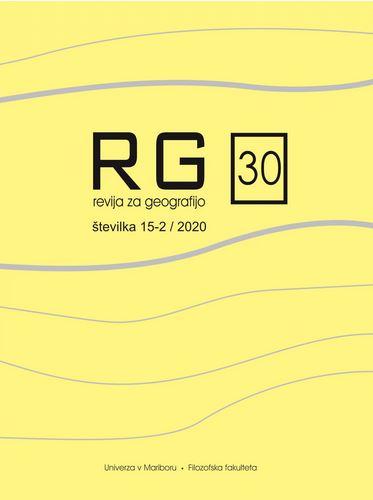Izboljševanje prostorske ločljivosti Landsat 8 termograma v luči mestnega toplotnega otoka
DOI:
https://doi.org/10.18690/rg.15.2.3642Ključne besede:
daljinsko zaznavanje, mobilne meritve, NDVI, satelitske podobe, termični kanalPovzetek
Dandanes več kot polovica ljudi živi v ubranih sistemih. Posledično se širijo pozidane površine, ki s svojimi lastnostmi ustvarjajo učinek mestnega toplotnega otoka, ki velja za enega izmed najbolj značilnih pojavov urbane gradnje in antropogenih aktivnosti. Pojav se zaradi globalnih podnebnih sprememb značilno krepi, kar dodatno vpliva na psihološko in fiziološko stanje ranljivih skupin ljudi. Njegovi vplivi segajo tudi na področje gospodarstva, še zlasti na porabo energije v mestih. Za uspešno načrtovanje omilitvenih in prilagoditvenih ukrepov, planiranje urbane zasnove ter trajnostni razvoj mest, so ključnega pomena analitične študije pojava mestnega toplotnega otoka, pri katerih se uporablja kombinacija podatkov in-situ meritev in podob daljinskega zaznavanja. Pri uporabi slednjih smo pogosto omejeni s prostorsko ločljivostjo termičnih kanalov.
Prenosi
Literatura
Chen, X.-L., Zhao, H.-M., Li, P.-X., Yin, Z.-Y. 2006: Remote sensing image-based analysis of the relationship between urban heat island and land use/cover changes. Remote Sensing of Environment, 133-146. https://doi.org/10.1016/j.rse.2005.11.016
Cho, K., Kim, Y., Kim, Y. 2018: Disaggregation of Landsat-8 Thermal Data Using Guided SWIR Imagery on the Scene of a Wildfire. Remote Sensing 10(1), 105. https://doi.org/10.3390/rs10010105
Eastman, J. 2016: TerrSet. Clark Labs-Clark University.
ESA 2020: Copernicus Sentinel data.
ESRI 2020: ArcGIS Desktop, verzija 10.8. Redlands, Kalifornija: Environmental Systems Research Institute.
Gorgani, S. A., Panahi, M., Rezaie, F. 2013: The Relationship between NDVI and LST in the urban area of Mashhad, Iran. International Conference on Civil Engineering Architecture & Urban Sustainable Development , (str. 1-7). Tabriz , Iran.
Kaplan, G., Avdan, U., Avdan, Z. Y. 2018: Urban Heat Island Analysis Using the Landsat 8 Satellite Data: A Case Study in Skopje, Macedonia. Proceedings, 1-5.
Kustas, W. P., Norman, J. M., Anderson, M. C., French, A. N. 2003: Estimating subpixel surface temperatures and energy fluxes from the vegetation index–radiometric temperature relationship. Remote Sensing of Environment, 429-440. http://dx.doi.org/10.1016/S0034-4257(03)00036-1
Kyalo, D. K. 2017: Sentinel-2 and MODIS land surface temerature based evapotranspiration for irrigation efficiency calculations. Zaključno delo. Enschede, Nizozemska: Fakulteta za geoinformatiko, znanost in opazovanje zemlje.
Manoli, G., Fatichi, S., Schläpfer, M., Kailiang, Y., Crowther, T. W., Meili, N., BouZeid, E. 2019: Magnitude of urban heat islands largely explained by climate and population. Nature, 55-62. https://doi.org/10.1038/s41586-019-1512-9
Medmrežje 1. USGS. Pridobljeno iz EarthExplorer: https://earthexplorer.usgs.gov/; (9. 12 2020).
Medmrežje 2. ESA. Pridobljeno iz Copernicus Open Access Hub: https://scihub.copernicus.eu/dhus/#/home; (9. 12 2020).
Miles, V., Esau, I. 2020: Surface urban heat islands in 57 cities across different climate in northern Fennoscandia. Urban Climate, 1-11. https://ui.adsabs.harvard.edu/link_gateway/2020UrbCl..3100575M/doi:10.1016/j.uclim.2019.100575
Mirza, M. Q. 2003: Climate change and extreme weather events: can developing countries adapt? Climate Policy, 233–248. http://dx.doi.org/10.3763/cpol.2003.0330
Oke, T. R. 1973: City size and the urban heat island. Atmospheric Environment, 769-779. https://doi.org/10.1016/0004-6981(73)90140-6
Rizwan, A. M., Dennis, L. Y., Liu, C. 2008: A review on the generation, determination and mitigation of Urban Heat Island. Journal of Environmental Sciences, 120-128. https://doi.org/10.1016/s1001-0742(08)60019-4
Schwarz, N., Schlink, U., Franck, U., Großmann, K. 2012: Relationship of land surface and air temperatures and its implications for quantifying urban heat island indicators—An application for the city of Leipzig (Germany). Ecological Indicators, 693-704. https://doi.org/10.1016/j.ecolind.2012.01.001
Sobrino, J. A., Irakulis, I. 2020: A Methodology for Comparing the Surface Urban Heat Island in Selected Urban Agglomerations Around the World from Sentinel-3 SLSTR Data. Remote Sensing, 1-29. https://doi.org/10.3390/rs12122052
Stewart, I. D., Oke, T. R. 2012: Local Climate Zones for Urban Temperature Studies. Bulletin of the American Meteorological Society, 1879-1900. https://doi.org/10.1175/BAMS-D-11-00019.1
Sundara Kumar, K., Udaya Bhaskar, P., Padmakumari, K. 2012: Estimation of land surface temperature to study urban heat island effect using Landsat ETM+ image. International Journal of Engineering Science and Technology, 771-778.
Tam, B. Y., Gough, W. A., Mohsin, T. 2015: The impact of urbanization and the urban heat island effect on day to day temperature variation. Urban Climate, 1-15. http://dx.doi.org/10.1016/j.uclim.2014.12.004
Wang, W., Liu, K., Tang, R., & Wang, S. 2019: Remote sensing image-based analysis of the urban heat island effect in Shenzhen, China. Physics and Chemistry of the Earth, 168-175. https://doi.org/10.1016/j.pce.2019.01.002
Xu, X., Cai, H., Qiao, Z., Wang, L., Jin, C., Ge, Y., Wu, F. 2017: Impacts of Park Landscape Structure on Thermal Environment Using QuickBird and Landsat Images. Chinese Geographical Science, 818-826. http://dx.doi.org/10.1007/s11769-017-0910-x
Yang, L., Qian, F., Song, D.-X., Zheng, K.-J. 2016: Research on Urban Heat-island Effect. Procedia Engineering, 11-18. http://dx.doi.org/10.1016/j.proeng.2016.10.002
Yuan, F., Bauer, M. E. 2006: Comparison of impervious surface area and normalized difference vegetation index as indicators of surface urban heat island effects in Landsat imagery. Remote Sensing of Environment, 1-12. http://dx.doi.org/10.1016/j.rse.2006.09.003
Zawadzka, J., Corstanje, R., Harris, J., Truckell, I. 2019: Downscaling Landsat-8 land surface temperature maps in diverse urban landscapes using multivariate adaptive regression splines and very high resolution auxiliary data. International Journal of Digital Earth, 1-16. https://doi.org/10.1080/17538947.2019.1593527
Zhou, B., Rybski, D., Kropp, J. P. 2017: The role of city size and urban form in the surface urban heat island. Scientific reports, 1-9. https://doi.org/10.1038/s41598-017-04242-2
Prenosi
Objavljeno
Številka
Rubrika
Licenca
Avtorske pravice (c) 2020 Veno Jaša Grujić, Mitja Kaligarič, Sonja Škornik, Nataša Pipenbaher, Igor Žiberna, Lučka Kajfež-Bogataj, Zalika Črepinšek, David Pintarič, Danijel Ivajnšič, Daša Donša

To delo je licencirano pod Creative Commons Priznanje avtorstva 4.0 mednarodno licenco.
